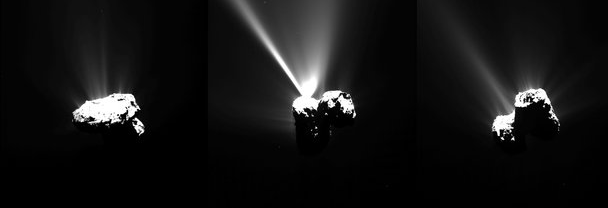[SatNews] ESA’s Rosetta witnessed Comet 67P/Churyumov–Gerasimenko making its closest approach to the Sun. The exact moment of perihelion occurred at 02:03 GMT this morning when the comet came within 186 million km of the Sun.
In the year that has passed since Rosetta arrived, the comet has traveled some 750 million kilometers along its orbit towards the Sun, the increasing solar radiation heating up the nucleus and causing its frozen ices to escape as gas and stream out into space at an ever greater rate. These gases, and the dust particles that they drag along, build up the comet’s atmosphere – coma – and tail.

Approaching perihelion Released 13/08/2015 4:30 pm Copyright ESA/Rosetta/MPS for OSIRIS Team MPS/UPD/LAM/IAA/SSO/INTA/UPM/DASP/IDA This series of images of Comet 67P/Churyumov–Gerasimenko was captured by Rosetta’s OSIRIS narrow-angle camera on 12 August 2015, just a few hours before the comet reached the closest point to the Sun along its 6.5-year orbit, or perihelion. The image at left was taken at 14:07 GMT, the middle image at 17:35 GMT, and the final image at 23:31 GMT. The images were taken from a distance of about 330 km from the comet. The comet’s activity, at its peak intensity around perihelion and in the weeks that follow, is clearly visible in these spectacular images. In particular, a significant outburst can be seen in the image captured at 17:35 GMT.
Approaching perihelion – Animation
The activity reaches its peak intensity around perihelion and in the weeks that follow, and is clearly visible in the spectacular images returned by the spacecraft in the last months. One image taken by Rosetta’s navigation camera was acquired at 01:04 GMT, just an hour before the moment of perihelion, from a distance of around 327 km.
The scientific camera is also taking images today, the most recent available image was taken at 23:31 GMT on 12 August, just a few hours before perihelion. The comet’s activity is clearly seen in the images, with a multitude of jets stemming from the nucleus, including one outburst captured in an image taken at 17:35 GMT yesterday.
“Activity will remain high like this for many weeks, and we’re certainly looking forward to seeing how many more jets and outburst events we catch in the act, as we have already witnessed in the last few weeks,” says Nicolas Altobelli, acting Rosetta project scientist.
Comet at perihelion
Rosetta’s measurements suggest the comet is spewing up to 300 kg of water vapor, roughly the equivalent of two bathtubs, every second. This is a thousand times more than was observed this time last year when Rosetta first approached the comet. Then, it recorded an outflow rate of just 300 g per second, equivalent to two small glasses of water.
Along with gas, the nucleus is also estimated to be shedding up to 1000 kg of dust per second, creating dangerous working conditions for Rosetta.
“In recent days, we have been forced to move even further away from the comet. We’re currently at a distance of between 325 km and 340 km this week, in a region where Rosetta’s startrackers can operate without being confused by excessive dust levels, without them working properly, Rosetta can’t position itself in space,” comments Sylvain Lodiot, ESA’s spacecraft operations manager.